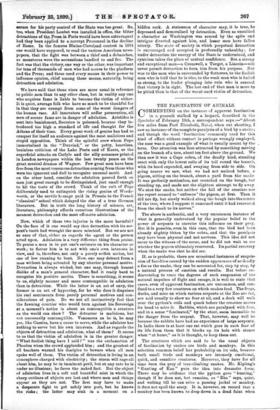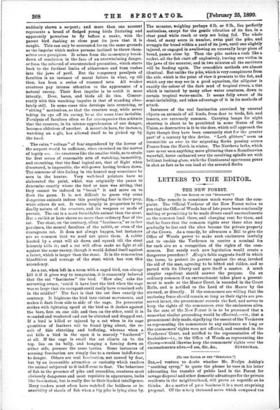THE FASCINATION OF ANIMALS.
COMMENTING on the instance of apparent fascination in a peacock stalked by a leopard, described in the Spectator of February 18th, a correspondent says :—" About five miles from Port Elizabeth, Natal, when out shooting, I saw an instance of the complete paralysis of a bird by a snake; and though the word fascination' commonly used for this kind of effect without contact is perhaps wrongly employed, the case was a good example of what is usually meant by the term. Our attention was first attracted by something moving on the branch of a tree, about ten feet above the ground. We then saw it was a Cape cobra, of the deadly kind, standing erect with only the lowest coils of its tail round the branch, with its hood expanded, and swaying from side to side. On going nearer we saw, what we had not noticed before, a pigeon, sitting on the branch, about a yard from the snake It was perfectly motionless, not crouched on the bough, but standing up, and made not the slightest attempt to fly away. We shot the snake, but neither the fall of the creature nor the report seemed to ' unfreeze' the pigeon, at first. Then it did not fly, but slowly walked along the bough into the centre of the tree, where I suppose it remained until it had recovered from the shock to its nerves."
The above is authentic, and a very uncommon instance of what is generally understood by the popular belief in the power of serpents to exercise this influence on their prey. But it is possible, even in this case, that the bird had been already slightly bitten by the cobra, and that the paralysis may have been physical and not nervous. This idea did not occur to the witness of the scene, and he did not wait to see whether the pigeon ultimately recovered. Its partial recovery when the snake was shot he did see.
If, as is probable, there are occasional instances of suspen- sion of faculties caused by the sudden appearance of so deadly a foe as the snake, they can be accounted for, step by step, by a natural process of emotion and results. But before en• deavouriug to trace the degrees of such suspension of the natural impulses of flight and escape, it is well to state that cases, even of apparent fascination, are uncommon, and con- fined to a very few creatures on which snakes feed. The frogs, ducks, and mice on which various serpents at the Zoo are fed, are said usually to show no fear at all, and a duck will walk over the python's coils and quack before the creature moves its head to seize it. Rabbits, which are paralysed with fear, and in a sense "fascinated," by the stoat, seem insensible to the danger from the serpent. That, however, may well be because the rabbits have had no experience of large serpents. In India there is at least one rat which goes in such fear of its life from them that it blocks up its hole with stones when " at home," as it is thought, to keep them out.
The creatures which are said to be the usual objects of fascination by snakes are birds and monkeys. In this selection common belief has probability on its side, because both small birds and monkeys are intensely emotional, quick, and sensitive creatures. Moreover, they have for all time been the prey of tree-climbing snakes. Mr. Kipling's " Hunting of Kaa" puts the idea into dramatic form. There may be evidence that the python goes " hunting," though if he does not, but remains, as " Eha " says, quiet, and waiting till he can seize a passing jackal or monkey, it does not spoil the story. It is, however, on record that a monkey has been known to drop down in a dead faint when
suddenly shown a serpent ; and more than one account represents a brood of fledged young birds fluttering and apparently powerless to fly before a snake, with the parent bird dashing so close past its jaws that it is caught. This can only be accounted for on the same grounds as the impulse which makes persons inclined to throw them- selves over precipices. It arises from the momentary break- down of resolution in the face of an overwhelming danger, or from the rebound of overstretched precaution, which starts back to the furthest limits of abhorrence and then rushes into the jaws of peril. But the temporary paralysis of faculties is an instance of moral failure in what, up till then, has been a series of reasoned acts. All weaker creatures pay intense attention to the appearance of a," natural enemy. Their first impulse is to watch it most intently. Deer, bares, and birds all do this. Concur- rently with this watching impulse is that of standing abso- lutely still. In some cases this develops into crouching, or " sitting " motionless, so that the creature may, while never taking its eye off its enemy, be at the same time invisible. Paralysis of faculties often so far accompanies this attitude that the creature, in its intense apprehension of one danger, becomes oblivious of another. A mount Lin hare, for instance, watching an eagle, has allowed itself to be picked up by the haud.
The extra " voltage" of fear engendered by the horror of the serpent wonld be sufficient, when exercised on the nerves of highly sea, ive creatures like the smaller birds, so to strain the first series of reasonable acts of watching, immobility, and crouching, that the final logical act, that of flight when discovered, is impossible, the will-power having broken down. The converse of this feeling in the hunted may sometimes be seen in the hunter. Very well-bred pointers have so elaborated the point, which was originally the pause to determine exactly where the bird or hare was sitting, that they cannot be induced to " break " it and move on to flash the game. It is not difficult to guess why some dangerous animals induce this paralysing fear in their prey, while others do not. It varies largely in proportion to the deadly nature of the creature, and its weapons or mode of pursuit. The cat is a more formidable animal than the stoat. But a rabbit or hare shows no more than ordinary fear of the cat. The stoat, on the contrary, often " fascinates," or rather paralyses, the mental faculties of the rabbit, or even of the courageous rat. It does not always happen, but instances are so common that we need not quote them. A rabbit hunted by a stoat will sit down and squeak till the stoat leisurely kills it; and a rat will often make no fight at all against the same enemy, though it would defend itself against a ferret, which is larger than the stoat. It is the remorseless bloodthirst and courage of the stoat which has won this ascendency.
As a cat, when left in a room with a caged bird, can always kill it if it gives way to temptation, it is commonly believed
that the cat "fascinates" the bird. How else,' asks the sorrowing owner, 'could it have hurt the bird when the cage was so large that its occupant could easily have remained safe in the middle?' The fact is that the cat does exactly the contrary. It frightens the bird into violent movements, and makes it dash from side to aide of the cage. Its persecutor strikes with lightning speed at the bird as it dashes against the bars, first on one side and then on the other, until it is wounded and weakened and can be clutched and dragged out. If a bird is killed or injured by a cat when in its cage quantities of feathers will be found lying about, the re- sult of this clutching and buffeting, whereas when a cat kills a bird in the open it is scarcely "feathered" at all. If the cage is small the cat climbs on to the top, lies on its belly, and hanging a fore-leg down on either side, pursues the same tactics. Some instances of seeming fascination are simply due to a curious indifference to danger. Others are real fascination, not caused by fear, but by an irresistible attraction or curiosity which renders the animal subjected to it indifferent to fear. The behaviour of fish in the presence of pike and crocodiles, creatures most obviously dangerous and most repulsive in appearance, looks like fascination, but is really due to their limited intelligence. Many readers must often have watched the boldness or in- sensibility of shoals of fish when a big pike is lying close by. The monster, weighing perhaps Bib. or 8 lb., lies perfectly motionless, except for the gentle vibration of its fins, in a clear pond while roach or carp are being fed. The whole shoal, of many score in number, swim past the pike, and struggle for bread within a yard of its jaws, until one slightly injured, or engaged in swallowing an unusually large piece of bread, passes close by. Then the pike makes a rush like a rocket, all the fish start off explosively, leaving one victim in the jaws of the monster, and in two minutes all the survivors will be feeding again. The crocodile's methods are almost identical. But unlike the pike, which is very conspicuous from the side, which is the point of view it presents to the fish, and which any one may see in a good aquarium, the alligator is exactly the colour of the dark mud of tropical rivers, a tint which is imitated by many other water creatures, down to certain tropical water-snails. It seems fully aware of its semi-invisibility, and takes advantage of it in its methods of attack.
Instances of the real fascination exercised by unusual objects on animals of all kinds, from deer to birds, fish, and insects, are extremely common. Carrying lamps for night shooting is about to be prohibited in some States of the Union, so destructive ie it to the deer, which will approach the light though they have been constantly shot for the greater part' of a century by this device. "Lark glitters" seem as irresistible as ever to the migrating flocks passing across France from the North in winter. The Northern larks, which have never seen anything more glittering than a Scandinavian waterfall, hover enchanted over the revolving spindle set with brilliant looking-glass, while the Continental sportsman pours in shut as fast as he can load at the arrested flocks.







































 Previous page
Previous page